Uncalibrated
Results
Brightness and Contrast Ratio
For the brightness, contrast, and color accuracy tests, we depend on the hardware colorimeter and software to help calibrate the displays. As previously stated, we use a Monaco Optix XR (DTP-94) colorimeter and Monaco Optix XR Pro software. The software and hardware help users to get color that is more accurate from their displays. Before we get to the calibrated results, we took a quick look at the range of brightness and contrast at stock settings while changing just the brightness level.
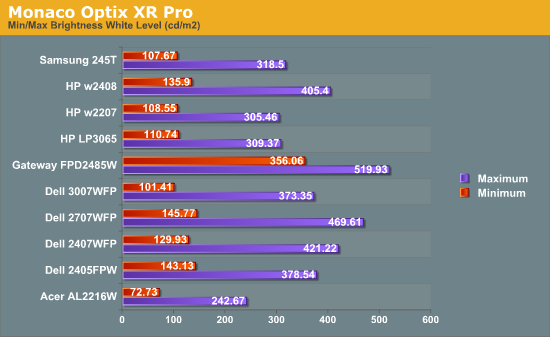
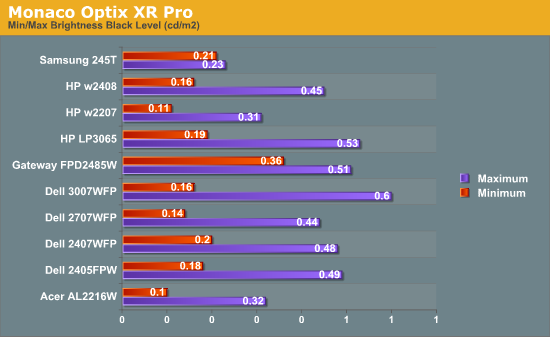
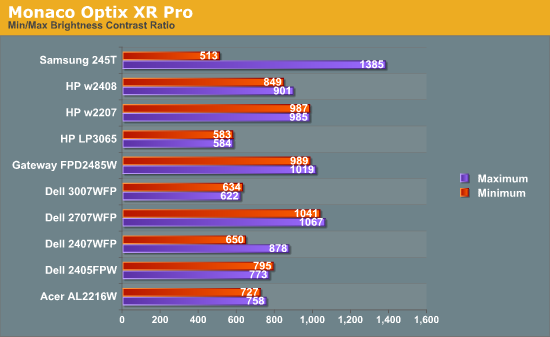
Without adjusting any of the default settings other than brightness, the maximum brightness level of the Samsung 245T reaches almost 320 nits -- as usual, more than most people need. At minimum brightness, we measure just over 100 nits. Further tuning of the color levels allows us to reach slightly lower/higher brightness levels, but the default range is sufficient. At maximum brightness, we measure a contrast ratio of nearly 1400:1 -- even without the dynamic contrast setting enabled. Reducing the brightness also reduces the contrast ratio, and it's interesting to note that black levels are reasonably stable at around 0.22 nits.
What happens when we enable Dynamic CR? Maximum brightness jumps to 350 nits while the black level went up slightly to 0.24 nits, resulting in a final contrast ratio of 1460:1. That's pretty close to the advertised 1500:1 contrast ratio, but the impact on Delta E is quite severe. Even after calibration -- which appears to get confused by Dynamic CR -- we measured an average Delta E of 7.029. That's worse than the uncalibrated Delta E we'll see below, so we recommend turning off the dynamic contrast.
Color Accuracy
The problem with calibrating a display is that it doesn't help all applications. Specifically, the video overlay used when watching DVDs or other movies completely bypasses any color profiles, so you are stuck with the uncalibrated colors. Playing games also uses the default color options. It is possible to tweak things using the OSD, but the amount of color correction that can be done via the OSD pales in comparison to color correction tables. Ideally, we would like to see video drivers begin to apply color profiles to all output -- office applications, movies, games, or anything else.
For uncalibrated color accuracy, we adjust the brightness as well as the contrast and colors (where applicable) using a "calibrate by eye" chart and the OSD controls. Also remember that color accuracy can vary from panel to panel even within the same model, and the results we are reporting are only from testing a single LCD. During testing, Monaco Optix XR Pro sends 24 color patches to the display with the colorimeter measuring the resulting values. The difference between what the requested and actual colors shown on the LCD is Delta E, with lower values being better. Any score less than one is "perfect" -- the naked eye is not going to be able to tell the difference -- and scores less than 2.0 are nearly perfect.
Ideally, you would want all of the tested colors to have a Delta E of less than 1.0, but almost no one is likely to have problems with anything scoring below 2.0. From 2.0 to 4.0, most people still won't notice the slight inaccuracies in the color palette, but when comparing displays side-by-side, differences may be apparent -- multimedia professionals in particular would prefer better colors. Anything above 4.0 begins to represent a more significant deviance, and numerous scores above 6.0 will almost certainly be noticeable by anyone using the display. Consistency is also important, so a display that has very good scores overall but with high spikes on some colors may actually be less desirable than a display with a slightly higher but more consistent average Delta E. Note also that fluctuations of as much as one point in Delta E are possible during a short amount of time. It generally takes 30 minutes for a display to warm up, and we perform all of our calibration and testing after the displays have been running for at least one hour with the screensaver disabled.
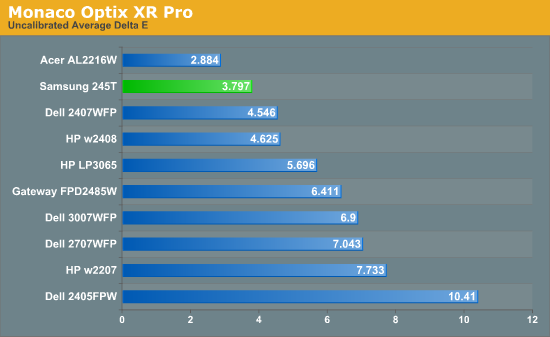
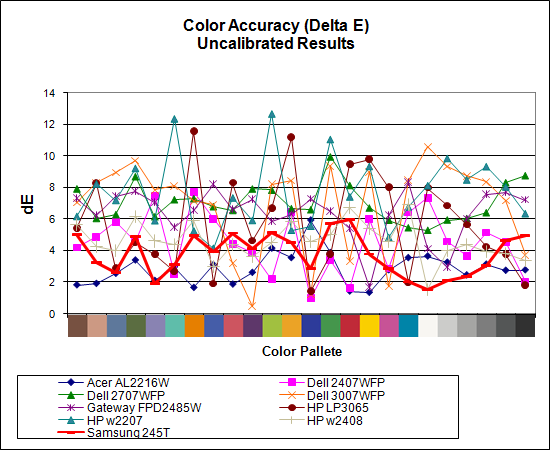
Without any form of color correction, the Samsung 245T rates a very good -- especially relative to the competition -- 3.80, ranking second overall with a relatively large gap between it and the nearest competitors. The Acer still scored better, but with that display had other concerns. The individual color scores are also very good, with the worst still only 6.0 and many others are below 3.0. So far, this is the best overall display when it comes to color accuracy -- provided of course that you stay away from the Dynamic CR setting. It's not perfect, but after seeing so many LCDs with uncalibrated Delta E of over 6.0 this is definitely a noteworthy achievement.










60 Comments
View All Comments
daarrid - Wednesday, August 13, 2008 - link
First, I'd like to thank Jarred Walton for his excellent review. A great deal of work goes into such a review. So, first and foremost, thank you sir! I'm also impressed by your timely follow-ups to the comments that have been posted.I just purchased the Samsung 245T (August, 2008). The firmware evidently has changed because there are new scaling options.
I'm only using two inputs - the VGA for various computers connected to it via a KVM and a Sony Playstation via the HDMI.
The VGA input now shows three options for size: wide, 16:9 (this is new), and 4:3. Wide is the only useful option (it appears to be 1:1 pixel mapping). The other two options distort the display. Why 16:9 was added as a choice is hard to say because it adds no useful function I can think of.
However on the HDMI input (and perhaps the DVI - I didn't test the DVI input) we have the old choices - Wide, 16:9, 4:3 and a new one! The new one is called "Just Scan" which seems to be 1:1 pixel mapping. Samsung evidently is listening.
bobo51 - Thursday, June 26, 2008 - link
I find it interesting that 4 months after Jarred was reassured by his contact at Samsung that this panel was a PVA, it is still speced as a TN panel on the Samsung website. And the mail order websites that report this characteristic seem to just parrot what is on the Samsung website.It would seem that it being a PVA unit would be a marketing point that Samsung would want to be front-and-center in their specs and advertising. So why isn't it out there?
Does anyone have any written documentation or labeling on the back of a unit (or anything other than someone's statement) that this is a PVA panel?
maxdog - Friday, August 22, 2008 - link
All of the 24" panels on the Samsung website state the same type. I'd like to know for sure.TrinityJayOne - Saturday, June 7, 2008 - link
Just thought I'd point out that there's an error in this review regarding display modes. It's true that there's no 1:1 pixel-mapping, but there IS a 16:9 option, it just isn't available when using a DVI source (I'm guessing because Samsung figure DVI = PC only and video cards support 16:10 resolutions). For HDMI, component, S-video etc, the 16:9 option will keep your 1080p signal un-squished and 720p will be upscaled. Check it out for yourself in the user guide, about 2/3 of the way down the page- http://downloadcenter.samsung.com/content/EM/20070...">http://downloadcenter.samsung.com/conte.../200707/...XrayDoc - Wednesday, April 2, 2008 - link
The new Dell 2408WFP has been available for perhaps a month. When are we going to see a killer review on AnandTech?machspeed5 - Saturday, February 16, 2008 - link
Conflicting Information!!!Page 4 of this trustedreview of the 245T states "genuine 1:1 pixel mapping"
http://www.trustedreviews.com/displays/review/2007...">http://www.trustedreviews.com/displays/.../2007/11...
".....A tonne of connectivity only adds to the appeal, as does the genuine 1:1 pixel mapping from 1080p sources."
This Anadtech review clearly states the opposite!
Who is correct here? Clarification appreciated, as you've thrown a monkey wrench in my purchasing decision! :P
Thanks
machspeed5 - Saturday, February 16, 2008 - link
found this:source: http://www.hardforum.com/showthread.php?p=10319083...">http://www.hardforum.com/showthread.php?p=10319083...
According to the User's Manual:
- if the video source is connected through PC/ DVI, you will be able to switch the size between "Wide" and "4:3";
- if the video source is connected through Composite/ S-Video, you will be able to set the size to "Wide", "16:9", "Zoom1", "Zoom2" or "4:3";
- if the video source is connected trough Component/ HDMI, you will then be able to choose the size between "Wide", "16:9" or "4:3".
Supposedly, by "Wide", they mean "Full screen" (1920x1200).
I don't really know what they mean by "Zoom1" and "Zoom2", but I guess this is some scale of "expansion" (by keeping the aspect ratio). But I insist, this is just me guessing; I do not own the screen.
As matter of fact, this leads also to the conclusion that there is no pure "1:1 pixel mapping" for all resolutions, even if you can get such pixel map for a HD 1080 lines source if you choose the "16:9" size.
can you confirm please, & perhaps update the review? many thanks.
JarredWalton - Saturday, February 16, 2008 - link
I checked the VGA and DVI connections... I didn't consider that they would add options on other inputs (most OSD controls gray out disabled options rather than removing them completely). I'm trying to come up with some meaningful "input lag" testing -- internal image processing lag would be more appropriate as a description -- so I'll see about testing the Component/HDMI/S-Video as well.Not surprisingly, I've got other things to review as well, so it might be a couple weeks before I get around to testing this.
machspeed5 - Sunday, February 17, 2008 - link
thanks.looking forward to seeing the input lag & HDMI pixel mapping options on the 245T. :)
word on the street is that the input lag is pretty bad, ~50ms, (2.5 frame lag.)
from my readings, 50ms (while on the upper end of laggy displays) may still be usable for all but the most time-sensitive games. (fps specifically) a lot of people complain and overrate the input lag problems on forums, though it's evident few understand what it is. (even confuse it with response time)
i'd appreciate hearing your opinion on the matter. I plan to use a PS3 with the 245T, and FPS will certainly be in the machine from time to time.
Genuine 1:1 pixel mapping is also important to me, and if you could clarify the issue here i'd be much appreciated.
cheers
Thetruepit - Monday, February 11, 2008 - link
It does suffer from inverse ghosting.Most noticeable in gaming mode so I don't use that.
Surprised it wasn't picked up. Also if you move your mouse cursor over a grey background you see noticeable ghosting.